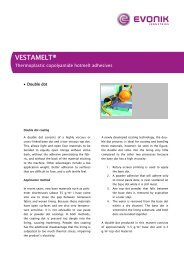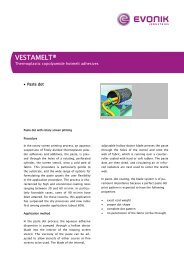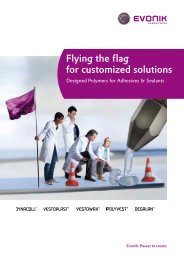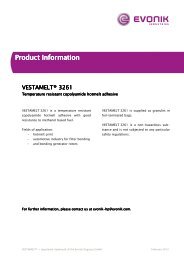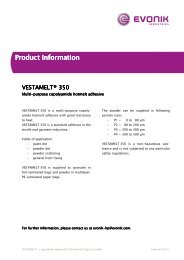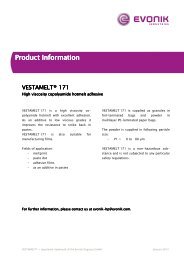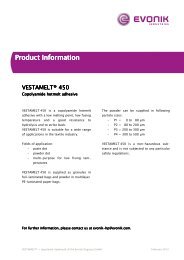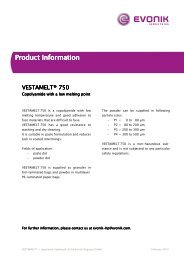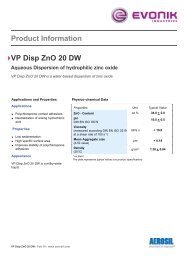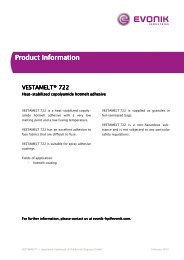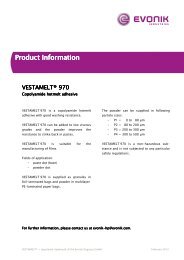AEROSIL® for Adhesives and Sealants - Adhesives & Sealants by ...
AEROSIL® for Adhesives and Sealants - Adhesives & Sealants by ...
AEROSIL® for Adhesives and Sealants - Adhesives & Sealants by ...
- No tags were found...
You also want an ePaper? Increase the reach of your titles
YUMPU automatically turns print PDFs into web optimized ePapers that Google loves.
SMD <strong>Adhesives</strong>SMD componentadhesivewired componentSMD adhesives attach the electronic device to the circuit board be<strong>for</strong>ethe completed circuit boards are turned upside down <strong>for</strong> immersion in the soldering bath<strong>AEROSIL®</strong> – Advantages in <strong>Adhesives</strong><strong>for</strong> Electronic Components<strong>AEROSIL®</strong> helps the electronics industry in sticky situationsFor decades now, the electronics industryhas been the fastest growing <strong>and</strong> fastestchanging industry worldwide. <strong>Adhesives</strong>are used in the electronics industry toadhere electronic components to printedcircuit boards <strong>and</strong> to seal electroniccomponents (e.g. relays). Miniaturizationis the main trend in the development ofcircuit boards <strong>and</strong> in manufacturingtechnology. The introduction of SMDtechnology (Surface Mounted Device)in the 1980s, replacing the then st<strong>and</strong>ardwired elements, made it possible toachieve further miniaturization of thecomponents <strong>and</strong> a higher degree ofrationalization during fabrication. TheSMD process involves the direct solderingof the device contacts onto solder spotslocated on the surface of the circuit board.SMD adhesives play an important role inthe mounting of circuit boards withsubsequent soldering. They attach theelectronic devices to the circuit boardbe<strong>for</strong>e the completed circuit boards areflipped <strong>for</strong> immersion in the solderingbath. The adhesive is dispensed from acartridge; this requires the adhesive tohave a suitable drop profile. The volumeapplied must be sufficient to bridge thegap between the circuit board <strong>and</strong> theSMD components. The diameter of theglue spot must remain within the spacebetween the solder spots, withoutinadvertently wetting the connectionspots with glue. The drop profile of theadhesive is defined <strong>by</strong> the thixotropy,the viscosity in a state of resting, <strong>and</strong>the surface tension. Furthermore, theadhesive has to fulfill additional highrequirements during application:• Thixotropic flow behavior,high viscosity in resting state• Sag-resistance during thecuring process• High drop profile, no strings• Constant drop profile <strong>and</strong> volume• High green strength• High cure strength• Rapid cure rate• Guaranteed rapid applicationof very small drops• Bubble-free application, lowmoisture adsorptionBoth epoxy resin <strong>and</strong> acrylate-basedadhesives are available <strong>for</strong> use as SMDadhesives. The hydrophobic grades<strong>AEROSIL®</strong> R 972, <strong>AEROSIL®</strong> R 202, <strong>and</strong><strong>AEROSIL®</strong> R 805 are very effectivethixotropic agents <strong>for</strong> these adhesives.SMD adhesives can be adjusted using<strong>AEROSIL®</strong> R 972, <strong>AEROSIL®</strong> R 202, <strong>and</strong><strong>AEROSIL®</strong> R 805, to fulfill the dem<strong>and</strong>s<strong>for</strong> thixotropic flow behavior, highviscosity in resting state, high dropprofile, <strong>and</strong> anti-sagging during the curingprocess.15



